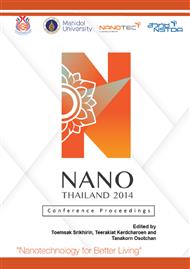[1]
P. Aunbamrung, A. Wongkaew, Effect of Cu Loading to Catalytic Selective CO Oxidation of CuO/CeO2-Co3O4, Adv. in Chem. Eng. and Sci. 3 (2013) 15-19.
Google Scholar
[2]
B. Lindstrom, L.J. Pettersson, Hydrogen generation by steam reforming of methanol over copper-based catalyst for fuel cell applications, Int. J. of Hydrogen Energy . 26(2001) 923-933.
DOI: 10.1016/s0360-3199(01)00034-9
Google Scholar
[3]
G. Postole, A. Auroux, The poisoning level of Pt/C catalysts used in PEM fuel cells by the hydrogen feed gas impurities: The bonding strength, Int. J. of Hydrogen Energy. 36 (2011) 6817–6825.
DOI: 10.1016/j.ijhydene.2011.03.018
Google Scholar
[4]
G. Avgouropoulos, T. Ioannides, Ch. Papadopoulou, J. Barista, S. Hocevar, H.K. Matralis, A comparative study of Pt/Al2O3, Au/Fe2O3 and CuO–CeO2 catalysts for the selective oxidation of carbon monoxide in excess hydrogen, Catal. Today. 75 (2002).
DOI: 10.1016/s0920-5861(02)00058-5
Google Scholar
[5]
A. Wongkaew, W. Kongsi, P. Limsuwan, Physical Properties and Selective CO Oxidation of Coprecipitated CuO/CeO2 Catalysts Depending on the CuO in the Samples, Adv. in Mater. Sci. and Eng. 2013 (2013) Article ID 374080 8 pages.
DOI: 10.1155/2013/374080
Google Scholar
[6]
A. Razeghi, A. Khodadadi, H. Ziaei-Azad, Y. Mortazavi, Activity enhancement of Cu-doped ceria by reductive regeneration of CuO–CeO2 catalyst for preferential oxidation of CO in H2-rich streams, Chem. Eng. J. 164 (2010) 214–220.
DOI: 10.1016/j.cej.2010.07.064
Google Scholar
[7]
L.F. Liotta, G. Di Carlo, G. Pantaleo, A.M. Venezia, Supported gold catalysts for CO oxidation and preferential oxidation of CO in H2 stream: Support effect, Catal. Today. 158 (2010) 56-62.
DOI: 10.1016/j.cattod.2010.04.049
Google Scholar
[8]
S. Varghese, M.G. Cutrufello, E. Rombi, C. Cannas, R. Monaci, I. Ferino, CO oxidation and preferential oxidation of CO in the presence of hydrogen over SBA-15-templated CuO–Co3O4, Appl. Catal. A 443–444 (2012) 161–170.
DOI: 10.1016/j.apcata.2012.07.038
Google Scholar
[9]
Y. Chen, D. Liu, L. Yang, M. Meng, J. Zhang, L. Zheng, S. Chu, T. Hu, Ternary composite oxide catalysts CuO/Co3O4–CeO2 with wide temperature-window for the preferential oxidation of CO in H2-rich stream, Chem. Eng. J. 234 (2013) 88–98.
DOI: 10.1016/j.cej.2013.08.063
Google Scholar
[10]
J.L. Ayastuy, A. Gurbani, M.P. Gonza-Marcos, M.A. Gutierrez-Ortiz, Effect of copper loading on copper-ceria catalysts performance in CO selective oxidation for fuel cell applications, Int. J. of Hydrogen Energy. 35 (2010) 1232-1244.
DOI: 10.1016/j.ijhydene.2009.11.098
Google Scholar
[11]
B.D. Filiz, G. Cigdem, Activity and selectivity of CO oxidation in H2 rich stream over the Ag/Co/Ce mixed oxide catalysts, Int. J. of Hydrogen Energy 35(2010) 2247-2261.
DOI: 10.1016/j.ijhydene.2009.12.177
Google Scholar
[12]
Y. Chen, D. Liu, L. Yang, M. Meng, J. Zhang, L. Zheng, S. Chu, T. Hu, Ternary composite oxide catalysts CuO/Co3O4–CeO2 with wide temperature-window for the preferential oxidation of CO in H2-rich stream, Chemi. Eng. J. 234(2013) 88–98.
DOI: 10.1016/j.cej.2013.08.063
Google Scholar
[13]
Y. Liu, X. Zhang, Effect of calcination temperature on the morphology and electrochemical properties of Co3O4 for lithium-ion battery, Electrochimica Acta 54(2009) 4180–4185.
DOI: 10.1016/j.electacta.2009.02.060
Google Scholar
[14]
Z. Liu, S.H. Chai, A. Binder, Y.Y. Li, L.T. Ji, S. Dai, Influence of calcination temperature on the structure and catalytic performance of CuOx-CoOy-CeO2 ternary mixed oxide for CO oxidation, Appl. Catal. A: General 451(2013) 282– 288.
DOI: 10.1016/j.apcata.2012.10.023
Google Scholar
[15]
A. Manasilp, E. Gulari, Selective CO oxidation over Pt/alumina catalysts for fuel cell applications, Appl. Catal. B: Environmental 37(1) (2002) 17–25.
DOI: 10.1016/s0926-3373(01)00319-8
Google Scholar
[16]
Z. Wu, H. Zhu, Z. Qin, H. Wang, J. Ding, L. Huang, J. Wang, CO preferential oxidation in H2-rich stream over a CuO/CeO2 catalyst with high H2O and CO2 tolerance Fuel 104(2013) 41–45.
DOI: 10.1016/j.fuel.2010.03.001
Google Scholar
[17]
Z. Gao, M. Zhou, H. Deng, Y. Yue, Preferential oxidation of CO in excess H2 over CeO2/CuO catalyst: Effectof calcination temperature, J. of Natural Gas Chemistry 21(2012)513–518.
DOI: 10.1016/s1003-9953(11)60399-x
Google Scholar


